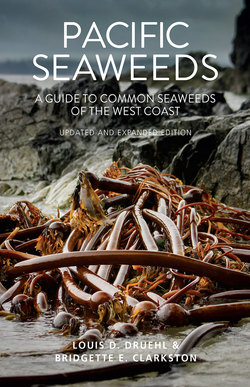Читать книгу Pacific Seaweeds - Louis Druehl - Страница 60
На сайте Литреса книга снята с продажи.
Оглавление60 | Blades
Pacific Seaweeds
Blades
The blade morphology is common among the major seaweed groups. In the green seaweeds, the blades are usually one or two cells thick. The blade’s thickness as well as its other dimensions are determined by the pattern of cell division. A game biologists play is to arrange species on the basis of morphological criteria. For example, one could establish a simple-to-complex lineage for some of the common green seaweeds. Imagine the green seaweed cell as being a cube. In an unbranched filament, this cube can divide in one plane only, resulting in a longer filament (Rhizoclonium, p. 52). In branched forms, the cube can occasionally divide in a second plane, giving rise to branches (Cladophora, p. 56). More or less equal cell divisions in two planes would result in a blade one cell thick (Prasiola, p. 61). Cell division limited to once in one plane, accompanied by equal and many cell divisions in two planes, would result in a blade two cells thick (bladed Ulva, p. 62). In some forms the two cell layers become disconnected, resulting in a hollow tube or sac (cylindrical Ulva, p. 66). Finally, the sac may tear, producing a blade one cell thick (Ulvaria, p. 64). Such an exercise may not contribute to our understanding of evolution, but it is instructive in appreciating how various forms come about.
Green blades of Ulva sp. in the high intertidal zone of Asilomar Beach, CA.
